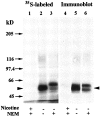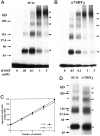Neuronal alpha-bungarotoxin receptors are alpha7 subunit homomers
- PMID: 10627589
- PMCID: PMC6774106
- DOI: 10.1523/JNEUROSCI.20-01-00133.2000
Neuronal alpha-bungarotoxin receptors are alpha7 subunit homomers
Abstract
Nicotinic acetylcholine receptors in the nervous system are heterogeneous with distinct pharmacological and functional properties resulting from differences in post-translational processing and subunit composition. Because of nicotinic receptor diversity, receptor purification and biochemical characterization have been difficult, and the precise subunit composition of each receptor subtype is poorly characterized. Evidence is presented that alpha-bungarotoxin (Bgt)-binding nicotinic receptors found in pheochromocytoma 12 (PC12) cells are pentamers composed solely of alpha7 subunits. Metabolically labeled, affinity-purified Bgt receptors (BgtRs) consisted of a single 55 kDa band on SDS gels, which was recognized by anti-alpha7 antibodies on immunoblots. Isoelectric focusing separated the 55 kDa band into multiple spots, all recognized by anti-alpha7 antibodies and, therefore, each a differentially processed alpha7 subunit. Cell-surface BgtR subunits, cross-linked to each other and (125)I-Bgt, migrated on gels as a ladder of five bands with each band a multiple of an alpha7 subunit monomer. Similar characteristics of BgtRs from rat brain suggest that they, like PC12 BgtRs, are alpha7 pentamers containing differentially processed alpha7 subunits.
Figures





References
-
- Alkondon M, Albuquerque EX. Diversity of nicotinic acetylcholine receptors in rat hippocampal neurons. I. Pharmacological and functional evidence for distinct structural subtypes. J Pharmacol Exp Ther. 1993;265:1455–1473. - PubMed
-
- Alkondon M, Rocha ES, Maelicke A, Albuquerque EXJ. Diversity of nicotinic acetylcholine receptors in rat brain. V. Alpha-bungarotoxin-sensitive nicotinic receptors in olfactory bulb neurons and presynaptic modulation of glutamate release. J Pharmacol Exp Ther. 1996;278:1460–1471. - PubMed
-
- Anderson AD, Troyanovskaya M, Wackym PA. Differential expression of alpha2–7, alpha9 and beta2–4 nicotinic acetylcholine receptor subunit mRNA in the vestibular end-organs and Scarpa's ganglia of the rat. Brain Res. 1997;778:409–413. - PubMed
-
- Betz H, Graham D, Rehm H. Identification of polypeptides associated with a putative neuronal nicotinic acetylcholine receptor. J Biol Chem. 1982;257:11390–11394. - PubMed
Publication types
MeSH terms
Substances
LinkOut - more resources
Full Text Sources
Molecular Biology Databases
